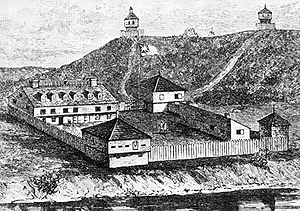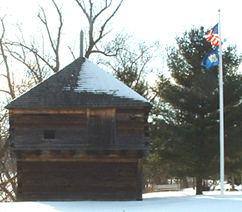DACF Home → Bureaus & Programs → Bureau of Parks and Lands → Discover History & Explore Nature → History & Historic Sites → Fort Halifax
Fort Halifax on the Kennebec
Northern Outpost for the Massachusetts Bay Colony
 Fort Halifax, in Winslow, Maine, is a National Historic
Landmark and the oldest blockhouse in the United States.
The sketch at left, drawn by one of its builders, depicts
the entire complex of Fort Halifax as it existed in 1755.
It included two main blockhouses, a barracks, and a main
building, as well as two additional blockhouses overlooking
the area from atop a nearby hill. The blockhouse in the
foreground is all that remains of the fort today built
by English settlers in 1754-1755, to defend the upper
Kennebec River Valley from possible attack by the French
and their Native American allies.
Fort Halifax, in Winslow, Maine, is a National Historic
Landmark and the oldest blockhouse in the United States.
The sketch at left, drawn by one of its builders, depicts
the entire complex of Fort Halifax as it existed in 1755.
It included two main blockhouses, a barracks, and a main
building, as well as two additional blockhouses overlooking
the area from atop a nearby hill. The blockhouse in the
foreground is all that remains of the fort today built
by English settlers in 1754-1755, to defend the upper
Kennebec River Valley from possible attack by the French
and their Native American allies.
During the 1600s and 1700s, conflict was common between England and France, both in Europe and the New World. When hostilities between the two nations erupted again in 1753-1754, the government of Massachusetts (which included Maine at the time) felt very threatened because the French could easily travel along Quebec’s Chaudiere River to reach English lands in the Kennebec River Valley. Deciding that a defensive work was needed to protect the valley, Massachusetts ordered the construction of Fort Halifax.
 After
five days of difficult travel by river and land from
Fort Western (in present-day Augusta), Major General
John Winslow arrived here with a force of 600 to establish
Fort Halifax on July 25, 1754. Winslow described the
activities that followed his arrival:
After
five days of difficult travel by river and land from
Fort Western (in present-day Augusta), Major General
John Winslow arrived here with a force of 600 to establish
Fort Halifax on July 25, 1754. Winslow described the
activities that followed his arrival:
...On the next day, laid out the ground, began to clear it, seated our guns and mortars, hoisted the Kings colors with the beat of drum and sound of trumpet and discharge of our whole artillery and small arms, drank to his Majesty and called this place Fort Halifax....in this place we continued employing our people... in cutting timber and pickets,...sawing boards and plank, building storehouses, getting clapboards and shingles, procuring stones out of the river, making bricks, burning coals, etc. and by the seventh of August got in a good posture of defense.
 When
the flood of April 1, 1987, dismantled the blockhouse,
crews recovered logs as far south as the Richmond-Dresden
Bridge, forty miles downstream (photo at right). The
blockhouse was painstakingly reassembled and remains
on its original site today.
When
the flood of April 1, 1987, dismantled the blockhouse,
crews recovered logs as far south as the Richmond-Dresden
Bridge, forty miles downstream (photo at right). The
blockhouse was painstakingly reassembled and remains
on its original site today.